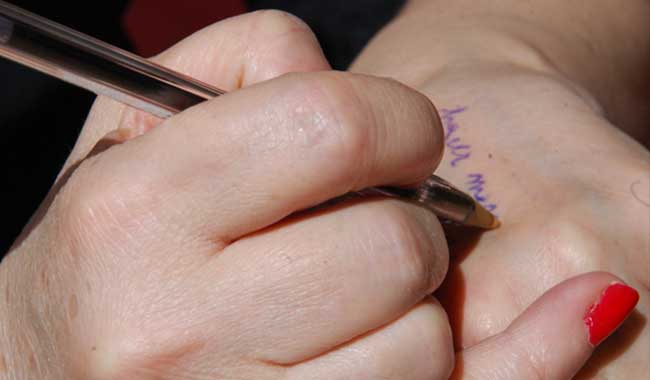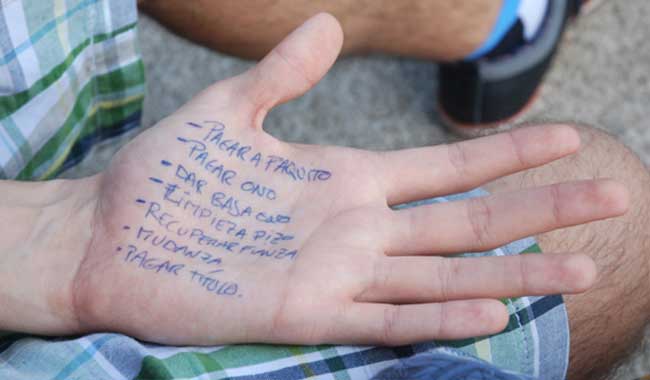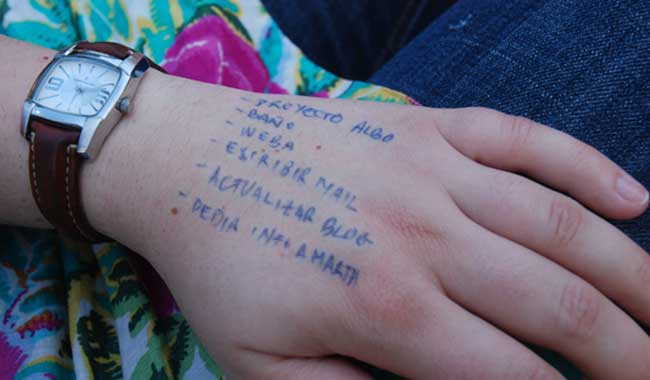

DECÁLOGO
Serie fotográfica (15 imágenes de 15 x 10 cm)
2011



La memoria del pasado no está hecha para recordar el pasado; está hecha para prevenir el futuro. La memoria es un instrumento de predicción.
Alain Berthoz (1939)
Cátedra de Fisiología de la percepción y la acción. Presidente del instituto de biología de Francia
“The memory of the past is not made to remember the past; it’s made to prevent the future. Memory is a prediction instrument”
Alain Berthoz (1939)
Chair of Perception and Action Physiology in the Biology Institute in France.
Mnemonics is a procedure of mental association to make easier the remembrance of something. Curiously, the remembrance in this meaning doesn’t refer to something past but an implacable future. By using images, signs or objects we recall a past moment in which we wanted to fix a future one.In daily routine many of us fix our obligations and tasks in the palm, or move any object that is always with us in the same place in a disciplinary way just to: “remember something”, or rather, “don’t forget something”. With this regulated wish, there are many methods that the individual uses to avoid dying before the oblivion crowd. Appointments, presentations of works, bills payment, celebrations, etc., they are commitments, accumulated day by day, and if they were delayed the result would be fateful.
To avoid that, we don’t store in memory all the information before the possibility that a fail happens, but we use a priori everything that is useful to put this “don’t forget about”, from a piece of paper to a pen-drive. If we make a stock list of the elements to put this information we would be surprised of its enormity. If we find really hard to transcribe a future wish just with a little number of letters to insinuate something, much more to find in which medium it is recorded.All that deployment of ways is just useful to corroborate the insecurity of the individual when he faces of his impossibility to remember something. The peculiarity of the matter is that we don’t refer to the past that form us but to the future.
We enter so, not just in a field of memory in which we just conceive it, as in its original conception but they interfere imaginable elements, and, what it’s more important, elements that are already undone, intangible projections just conceived in our mind.
This way, we know that without memory there is no past, but it doesn’t seem crazy think that now without memory there is no future. In my opinion, it has a certain kind of logic, because if memory is formed by learning: skills, attitudes, or ways of behaviour before different situations and emotions related to several facts…, all this allows that the planning of the future, whether it is immediate or not, makes the brain turned to that learning to situate the individual before the imaginary place.Although it seems categorical is unavoidable to make use of memory to shape, design and plan the future, as this one is a projection from the past, to which we resort inevitably to devise it. According with what I’ve described before, my conclusion is that present become past at the same moment in which we end the action, we are always living in the past, we just live a future as the figment of imagination, as it disappears when we blink.
We live eternally attached to a past, an unachievable feeling; but not because we would like to get rid of that feeling but, because we are not able to reject it. The taxonomy of the stands of accumulation of “diary tasks” gives as a result.